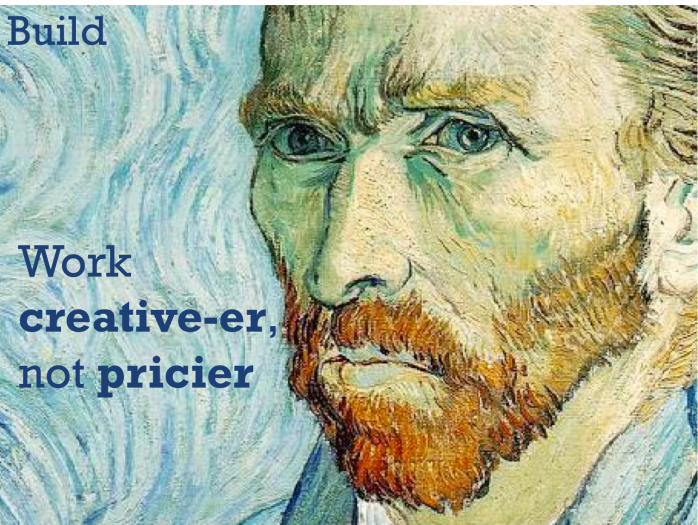I’ll hit on the next three slides together, because they are all around the same general topic: the idea of sampling/testing new marketing channels & projects before going big on investment.
In my last post I talked about the key Lean concept of Build Measure Learn. Another equally important idea is the MVP: the Minimum Viable Product. A lean company tries to get real feedback from real customers as early and often as possible, and that means not investing thousands of hours in developing a full-featured, well-polished product before you know that it’s something customers even care about. Instead, you develop just enough to get an idea if the product or feature is what people want. In some cases the MVP doesn’t even have to be a product; in the classic example from The Lean Startup, Dropbox drummed up demand for their file-sharing service with a video that described what it would do.
So how does this translate to marketing? Through the MVI: the Minimum Viable Investment.
The MVI is the smallest combination of resources– time, money, and staff– that you can apply to any new marketing channel or project while still yielding the learning you’re looking for. The idea is that before you go all in on a marketing project, you should test the waters first to see if it even makes sense. Or, as I put it in the next slide:
Oftentimes what this means is that before you outsource projects or hire staff or contractors, you should try things out in house and with the staff you have. Say you want to give paid search marketing a try, for example. Any agency you hire is likely to charge a setup fee for keyword research and is going to give you a list of hundreds or thousands of words that you’ll have to parse through to understand (or give up understanding), and in the end there’s a chance it might not even be the right channel for you. So instead of going straight to hiring an agency, why not just set up your own account on Google, add in 10-20 keywords, use Google’s automated bidding and budgeting tools to control your costs, and see if you can even approach the volume you need at a price per conversion that makes sense for you? You might not have the time or expertise to produce the most efficient and effective campaign possible, but you’ll get a good directional idea for whether that channel makes sense for you. If your efforts look promising, then it might make sense to get in a professional to polish the campaign up.
Another example is with events. I worked with a company that decided to sponsor a whole series of conferences aimed at the market they were targeting. It seemed like a great opportunity to get their brand and message in front of viable contacts and to network with people they wanted to meet. However, after attending a few of the events it became clear that although the general industry was right, the people coming to these conferences were from far smaller organizations than they generally hoped to meet, and the roles of the people weren’t quite right either. The overall sponsorship was quite expensive; add to that the cost of flying staff members to the conferences and putting them up in hotels as well as the staff time invested in preparing for and following up from the conferences, and it turned out to be a far less interesting opportunity than they had hoped.
They had made the mistake of going exploring in an aircraft carrier.
The good news is, they learned from that episode and the next time an event came up, they pulled out the canoe instead. They bypassed official sponsorships and booths and instead engaged in what they called “LobbyCon”. They bought a couple of attendee passes, signed up for several more free exhibit hall passes, put on matching t-shirts, hung out in common areas, and simply engaged people as they walked by. They didn’t spend thousands of dollars on printed materials, just armed themselves with business cards and little chocolates they offered as an icebreaker. They ended up far exceeding their goals for generating leads, and at a cost significantly less than their previous conference sponsorship. They got a sense for who was attending the conference and how easy it was to interact with them; now that they have seen the possibilities up close they have a better idea of whether to expand their investment next year. They followed the advice of Vincent van Gogh from my next slide:
Instead of just spending a lot of money, they used creativity and hustle, and in the process they gained learning about a particular new marketing channel. Even a sad fellow like Vincent would have to smile at that.
Related:
Lean Your Marketing: The Slide Deck
Slide 1 | Slide 2 | Slide 3 | Slides 4, 5, 6 | Slide 7 | Slide 8 | Slides 9 & 10 | Slides 11 & 12 | Slide 13 | Slide 14 | Slide 15 | Slide 16 | Slide 17 | Slides 18, 19 & 20


